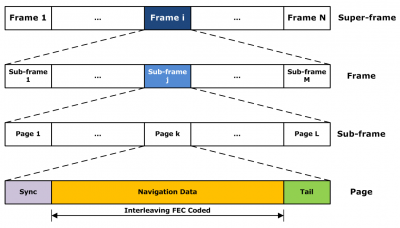If you wish to contribute or participate in the discussions about articles you are invited to contact the Editor
Galileo Navigation Message
| Fundamentals | |
|---|---|
| Title | Galileo Navigation Message |
| Author(s) | J. Sanz Subirana, JM. Juan Zornoza and M. Hernandez-Pajares, University of Catalunia, Spain. |
| Level | Basic |
| Year of Publication | 2011 |
The Galileo satellites will broadcast five types of data in four navigation messages: The Freely accessible Navigation Message (F/NAV) and Integrity Navigation Message (I/NAV), the Commercial Navigation Message (C/NAV) and the Governmental Navigation Message (G/NAV). Next table 2 summarises the content of the Galileo messages, with an indication of the associated channels and services (table inspired in [Hofmann-Wellenhof et al., 2008]).
As represented in the table above Galileo will offer several types of services with different purposes and to suit the needs of different types of users:
- The Integrity data will provide time-alarms and parameters to compute the integrity risk to support Safety-of-Life applications.
- The Supplementary data is expected to provide information to support different envisaged commercial services as differential corrections for High Precision Positioning Service, and different kind of information data as weather alerts, traffic information... The data is encrypted to control the access to authorised users by the service providers.
- The Public Regulated data is under governmental control and it is devoted to the Public Regulated Service (PRS). The system will guarantee a high continuity of service with controlled access by encryption of data.
- The Search and Rescue data will provide the capability to send acknowledgment SAR messages to a Beacon equipped with a suitable Galileo receiver.
The G/NAV navigation message does not belong to the public domain and the C/NAV is not yet defined.
According with the current published [Galileo SIS ICD, 2010] [1] both F/NAV and I/NAV navigation messages are called super-frame and broadcast as a sequence of frames that are composed of several sub-frames which in turn is composed by several pages. The general structure of the navigation messages are common but the number of sub-frames that composes the frame and the number of pages that composes the sub-frame as well as the duration of each page are not the same.
This arrangement allows accomplishing the three different main categories of data to be transmitted at different rates:
- Fast rate (for urgent data, such as integrity): page.
- Medium rate (Ephemeris, Clock Correction, ...): sub-frame.
- Slow rates (Almanacs): frame.
The page starts with a Synchronisation Word (SW) followed by the interleaving FEC (Forward Error Correction) coded navigation data and ends with tail bits for the FEC decoding. In addition both navigation messages transmit a CRC data field in order to detect corrupted data. The size of this field is different in each navigation message. Three levels of error coding are applied to the Galileo Message Data Stream:
- A Cyclic Redundancy Check (CRC) with error detection capabilities after recovery of the received data
- A one-half rate Forward Error Correction (FEC). Tail Bits (sequence of zeros) to allow Viterbi decoding.
- Block Interleaving on the resulting frames: provides robustness to the FEC decoding algorithm by avoiding packets of errors. This scheme allows reducing the bit error ratio in the increased data rates.
As referred, the FEC coded symbols are transmitted interleaved within the page and because of that the navigation data can only be read when the complete interleaving FEC coded part is received.
The Galileo ephemeris parameters are Keplerian-like orbital elements as in GPS. The nominal period update is 3 hours, being valid for a 4 hours time interval. The 1-hour overlap interval is intended to help against short outages or delays. The Galileo Almanac is also similar to the GPS and GLONASS ones.
Notes
References
- ^ [Galileo SIS ICD, 2010] Galileo Open Service Signal In Space Interface Control Document (OS SIS ICD) Issue 1, Revision 1, 1 September 2010, 2010
- Hofmann-Wellenhof, B., Lichtenegger, H., K. and Wasle, E., 2008. GNSS - Global Navigation Satellite Systems. Springer-Verlag, Wien, Austria.
- Powe, M., 2006. Introduction to Galileo. powerpoint presentation, progeny.



